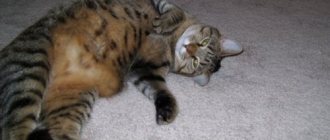Sometimes, when conducting a blood test, which cats have to take for one reason or another, a low level of white blood cells is detected. If such a result is confirmed upon repeated analysis, this is a sign indicating health problems. In such cases, the veterinarian usually prescribes additional examinations of the animal to identify and treat the disease that has led to a drop in the level of white blood cells. It is useful for a cat owner to know what leukocyte count is considered normal, and what to do if it is less or more abnormal.
Predisposing factors
Viral infections are the most common cause of leukopenia in cats. Feline immunodeficiency virus (FIV) and feline infectious peritonitis (FIP) are the most dangerous in this regard. Their peculiarity is that infectious agents can penetrate into the leukocytes themselves, where they successfully reproduce and destroy protective cells.
Of course, the number of the latter is sharply decreasing. Other causes of leukopenia may include:
- Bacterial infections. Moreover, this cause refers to almost everything: from abscesses to sepsis.
- Any inflammation causes a decrease in the number of leukocytes (and neutrophils in particular) if it has become chronic.
- All types of bone marrow diseases, including severe injuries, poisoning, exposure to radioactive materials.
- Pancreatitis. Inflammation of the pancreas will “pull” white blood cells from the bloodstream, which over time will lead to leukopenia.
- Certain medications. Corticosteroids, used to treat arthritis and other inflammatory pathologies, suppress the production of white blood cells when used long-term. As a rule, the pathology in this case is reversible.
- Stress. Long-term stress leads to many negative consequences for the body, including disruption of the bone marrow.
What you need to know about white blood cell levels in cats
Let's start with the fact that the normal number of leukocytes is 5.5-18.0 * 109/l. It is ideal if the level remains in this range. Unfortunately, with various diseases it can change significantly. For example, if the white blood cell count is elevated, this is an alarming sign - most likely there is some kind of inflammation in the body. But there is no need to worry right away. The cause may well be a mild cold.
© shutterstock
It is much worse if the level is significantly below normal. Then the diagnosis is simple - leukopenia. And this is already very bad. Often this disease is a consequence of sepsis - a serious reaction of the body to an invading infection. In this case, even the best medicines and high-quality treatment may not save the cat. However, there is no need to sound the alarm prematurely. Sometimes the white blood cell count drops simply because a large number of blood cells die in areas of inflammation. But if a critical decrease in the level of leukocytes in the blood persists not for several days, but for weeks, then the veterinarian will definitely prescribe serious treatment.
High-quality treatment from specialists
We offer our visitors the highest level of modern diagnostic equipment. The cat has low leukocytes Rostov-on-Don - we have the best treatment. Patients in intensive care and hospital are under constant medical supervision. The veterinary pharmacy, located in the lobby of the clinic, sells all the necessary medications to treat your pets. Here you will find EVERYTHING without long searches and with a guarantee of high quality! If necessary, you can order delivery of medicines, food and pet accessories to your home. To transport your pet, use our pet taxi, which will take you and your pet to the veterinary clinic from anywhere in Rostov-on-Don and the region. Call us, we will be happy to answer all your questions. By asking us a question you can get a free consultation with a doctor. Rest assured, by visiting the website of our veterinary clinic, you will always be able to find an up-to-date answer to your question, be it a description of a procedure or a description of rare diseases of dogs and cats. Our veterinary clinic conducts active educational work. On our website you can read articles devoted to various aspects of the treatment and care of animals, as well as a modern view of veterinary medicine.
Norm of analysis
To find out the number of leukocytes in an animal, you need to take a routine clinical blood test. Veterinarians often prescribe such a study when diagnosing various diseases or during a preventive examination. White blood cell levels can tell a lot about your pet's health.
The norm for cats is considered to be a leukocyte content from 5.5 x 10 3 / l to 18 x 10 3 / l. If the number of white blood cells is below acceptable values, then veterinarians call this condition leukopenia.
How to identify the disease
A low level of leukocytes in a cat’s blood can only be detected by the results of clinical tests. And it is advisable to identify any disease as early as possible - often the success of treatment depends on this. Therefore, it is very important to know what signs can be used to detect a decrease in leukocytes. We list the main symptoms:
- The animal often suffers from colds. In the most advanced cases, a cat can even catch pneumonia and chronic bronchitis.
- Indigestion that does not stop for a week or more even with a change in food.
- Inflammation of the gums - the cat refuses to eat because it hurts to eat.
- Deterioration of the condition of the coat and skin.
In the most advanced cases, conjunctivitis and bloody vomiting may appear. But this happens relatively rarely.
So, if you notice such signs in your pet, you should visit your veterinarian as soon as possible and get a referral for a complete blood count. The indicators obtained from the formula will allow you to more accurately determine the condition and, accordingly, make a more accurate diagnosis.
© shutterstock
Leukocytes are low in a Rostov-on-Don cat
> Animals
Low white blood cells in cats indicate serious problems with the immune system. These cells are responsible for protecting the body from infections. More often in animals, the analysis shows an increase in white blood cells.
This is a sign of an inflammatory process. After treatment, blood counts return to normal.
If leukocytes are low, this may indicate more serious problems with the pet’s health that require long-term treatment from a veterinarian.
Symptoms
If there are low leukocytes in a cat’s blood, this always affects the state of the immune system. The animal begins to get sick often, especially with colds. Complications such as pneumonia and bronchitis often develop.
With leukopenia, your pet often experiences gastrointestinal disorders. Even with proper nutrition and good care, the cat often suffers from vomiting and diarrhea.
The gums and oral cavity become inflamed. Because of this, the animal often refuses to eat. The pet is losing weight quickly. Inflammation of the eyes with purulent discharge appears. At the same time, the cat’s fur loses its shine and looks matted and unkempt. The skin is prone to inflammation.
If the owner discovers such symptoms in his pet, then he needs to take the cat to the veterinarian and do a blood test. It is possible that these phenomena are associated with leukopenia.
Symptoms
Often, the symptoms of panleukopenia in cats can resemble manifestations of other diseases. The pet becomes drowsy, lethargic, and stops eating. Vomiting appears, at first watery, with brownish or yellow foam, then mucus and blood may appear in the vomit.
Feline distemper is accompanied by fever (up to 41 °C and above) and diarrhea. Feces have a yellowish tint, a very unpleasant smell, and sometimes there is blood in them. The cat has a stomach ache, stands arched, or tries to hide in a dark place.
The mucous membranes become dry, the eyes stop shining. The skin becomes inelastic and slowly flattens out when folded. These signs indicate dehydration, which develops against the background of vomiting and diarrhea.
In small kittens, symptoms of panleukopenia may be absent, especially in the fulminant form of the disease. In other forms, the infection can be identified by the following signs:
- refusal of milk;
- lack of sleep;
- complete immobility or restless behavior accompanied by constant squeaking.
In older kittens (aged 3-7 months) and adults, panleukopenia is manifested by the following symptoms:
- restlessness, lack of sleep;
- refusal to eat and drink;
- vomit;
- diarrhea;
- heat;
- convulsions;
- paralysis of limbs.
The nature of the course of the disease depends on the age of the pet and the state of its immunity. In adult cats, the infection is less severe.
If you suspect feline distemper, you should immediately contact a veterinarian. You need to transport your pet very carefully. Place her in a carrier with soft bedding. On the road, try to avoid sudden movements, this will bring additional suffering to the cat.
Symptoms of panleukopenia in cats
The first signs of panleukopenia in cats should alert even inexperienced owners. Having realized that something strange is happening to your pet, you need to show it to the veterinarian as soon as possible. And even if it is often difficult to make an accurate diagnosis of panleukopenia on your own, a specialist will come to the rescue, explaining what actions are required from the owner and how the cat can be helped in this situation.
© shutterstock
These symptoms indicate the presence of the disease:
- the cat becomes lethargic and apathetic, it is not interested in anything;
- body temperature changes, it rises;
- with panleukopenia, the need for food decreases, up to a complete refusal of it;
- the cat may be thirsty or, on the contrary, the animal may stop drinking liquid altogether;
- breathing becomes heavy and quickens;
- the cat may have a fever;
- sometimes the skin becomes covered with ulcers.
As already mentioned, with panleukopenia the cat’s behavior changes, and it is simply impossible to notice this. The animal tries to hide away in a corner from people and avoids communicating with other pets. Not before now. She has a fever, and her body temperature can reach 41°C, when the norm is 38°C. In some cases, the cat may vomit mucus that is yellow-green in color. Urine with panleukopenia may change color to bright orange. And since this disease affects the gastrointestinal tract, the animal often suffers from diarrhea. There may even be some blood in the stool.
Main causes of the disease
As mentioned above, low leukocytes in cats affect the overall decline in immunity. To ensure successful treatment, you must first find out what is causing it.
First of all, it is, surprisingly, stress. If a cat lives in a state of stress for many months and years, this leads to a variety of negative consequences. These include disruption of the bone marrow and, as a result, a decrease in the number of white blood cells produced.
Another possible cause is certain medications. For example, some drugs used to treat arthritis suppress white blood cells, reducing their numbers in the blood. But in most cases the problem can be solved quite easily - just stop taking the medication or switch to another, safer analogue.
Any inflammation causes leukocytes and especially band neutrophils in the blood to drop sharply. Therefore, you need to fight the inflammation itself in order to solve the problem at the root.
© shutterstock
But there are also specific diseases due to which leukocytes in the blood are low:
- A range of bacterial infections, ranging from a common abscess to sepsis.
- Pancreatitis – with inflammation of the pancreas gradually leads to leukopenia.
- Bone marrow diseases are the most dangerous option, most often ending in the death of the cat.
Prevention
How to prevent leukopenia? Pet owners and veterinarians advise paying attention to the cat's diet. It must be balanced and enriched with B vitamins. You need to give your cat only high-quality food. Vitamin supplements should be used if necessary.
It is very important to protect your cat from frequent and prolonged stress. The pet must be protected from contact with dogs and aggressive relatives. The animal's independent walks should be minimized or completely eliminated.
If your cat is undergoing corticosteroid therapy, regular blood tests will be required. If there are signs of leukopenia, the dosage of medications must be adjusted.
If the animal has frequent colds, intestinal disorders, or deterioration in the quality of the coat, then the pet must be shown to a veterinarian. This will help identify leukopenia and promptly treat the underlying disease.
Good day. The cat is 17 years old, acute pyelonephritis at the age of 5, urolithiasis two years ago. The problem is that the nearest veterinary clinic is 70 km away. Urinari dry food, sometimes fiber. About six months ago I began to lose weight, screaming at first at night, then during the day, and having difficulty bowel movements, which was attributed to age. About 2 weeks ago I started refusing to eat. On February 13, 2021, we were taken to the clinic, had a blood test and were diagnosed with chronic renal failure. Blood test 02/13/2019 Leukocytes (WBC) – 2.1, Eosinophils – 13, Neutrophils J – 2, S/Y – 71, Monocytes (MON) -1 Lymphocytes (LIM) – 13, ALT – 31.9, Urea 13 .3, Creatinine 200.3, Glucose 6.2, Potassium 4.6 Prescription: *Roncoleukin 50,000 units, subcutaneously 1 time per day x 3 days
Causes of increased and decreased levels of leukocytes
A higher than normal level of leukocytes in the blood most often indicates the presence of an inflammatory process. This can be either a mild cold or allergens entering the body, or a serious illness caused by bacteria, viruses, or fungi. After treatment of the disease, the level of leukocytes normalizes, since an increased number of “fighters against foreign elements” is no longer required.
The cause of the appearance of leukocytes in the urine can be:
- cystitis (inflammation of the bladder),
- urethritis (inflammation of the urethra),
- nephritis or glomerulonephritis (inflammatory kidney disease).
The type of leukocytes and the consistency of urine sediment help determine the diagnosis.
A decrease in the number of leukocytes in a cat’s blood can be caused by the same reasons as an increase, but this phenomenon is more dangerous if it persists for a long time. A deficiency of white blood cells can occur due to their death in areas of inflammation. Severe or chronic diseases give a long-term picture of a low level of leukocytes, that is, the body cannot cope with their production.
In cases where the level of white blood cells is much lower than normal, the cat is diagnosed with leukopenia. The most common reasons for its development are:
- sepsis;
- malignant neoplasms;
- bacterial infections;
- pneumonia (pneumonia);
- infectious peritonitis;
- bone marrow diseases;
- pancreatitis;
- hepatitis (inflammatory liver diseases);
- poisoning;
- injury;
- severe allergies;
- Long-term use of certain medications (for example, corticosteroids), the side effect of which is a decrease in the production of white blood cells.
- chronic disease of any etiology in elderly animals.
Important! The most dangerous causes of leukopenia in cats are the immunodeficiency virus (FIV), infectious peritonitis (FIP) and feline distemper (parvovirus enteritis, or feline panleukopenia). Their pathogens penetrate inside leukocytes and destroy these protective cells. The mortality rate as a result of such diseases exceeds 90%.
Types of leukocytes
If the analysis reveals that the cat’s leukocytes are low, the doctor will prescribe an additional examination. It is called a leukogram. This test helps identify which type of white cells are elevated.
The following types of leukocytes exist:
- lymphocytes;
- neutrophils;
- eosinophils;
- basophils;
- monocytes.
Let's take a closer look at the possible reasons for the decrease in each of these types of blood cells:
- Lymphocytes are cells that recognize and reject foreign agents. This type of leukocytes can be reduced in chronic diseases of the liver, kidneys and lungs, immunodeficiency states, as well as during treatment with steroid hormones.
- Neutrophils destroy foreign proteins. A decrease in the number of these cells is observed in bacterial and fungal pathologies, anemia and bone marrow diseases. The cause of leukopenia in this case may also be the use of antifungal drugs or radiation therapy.
- Eosinophils fight allergens. A decrease in this type of cells is observed during acute infections, injuries, burns, and also after myocardial infarction. Eosinophilia is also seen in older cats.
- Basophils are rarely detected in the blood of cats. Their presence in the analysis usually indicates an allergy. Therefore, a decrease in basophils or their absence is not a sign of pathology.
- Monocytes reject dying cells and foreign proteins. A decrease in these blood elements can be observed with sepsis, bone marrow damage, as well as after childbirth and during treatment with corticosteroids.
We suggest you read: Is it possible to become infected with worms from a cat to a person and how are helminths transmitted?
Clinical manifestations
What are the symptoms of leukopenia in cats? Everything is quite simple here. Firstly, the animal is constantly sick. He is plagued by digestive disorders, and the cat constantly “catch” diseases of the upper respiratory tract. In severe cases, it can lead to chronic bronchitis and even pneumonia. Deterioration of the condition of the skin and coat, as well as inflammation of the gums and other periodontal diseases are often recorded. In addition, you can notice swollen and inflamed lymph nodes, the animal quickly gets tired, it is lethargic and apathetic. There is no appetite, the cat may experience constant cases of conjunctivitis, bloody diarrhea, vomiting... In short, the symptoms correspond to serious diseases of an infectious and inflammatory nature.
Let’s take a closer look at what each substance is responsible for and what to look for when interpreting tests in cats. Hematocrit (HCT)
Norm – 24-26%
Hematocrit (HCT). Norm – 24-26%
An increased number indicates a likely increase in the level of red blood cells (erythrocytosis), dehydration, the development of diabetes in the animal, and a decrease in plasma volume in the blood.
A decrease in hematocrit indicates anemia, chronic inflammation of one of the organs, cat starvation, the presence of cancer or internal infusion.
Hemoglobin (HGB). Norm – 80-150 g/l
An elevated hemoglobin level may indicate erythrocytosis or dehydration.
A reading below 80 g/l is a sign of one of several disorders, such as anemia, obvious or hidden blood loss, poisoning, or damage to the hematopoietic organs.
White blood cells (WBC). Norm – 5.5-18.0*109/l
Exceeding the norm: leukemia, development of bacterial infections or inflammatory processes, oncology.
Decreased normal: virus, bone marrow damage, damage to the body due to radioactive radiation.
Red blood cells (RGB). Norm – 5.3-10*10 12 /l
An increased level of red blood cells means the development of erythrocytosis in the body, lack of oxygen, and dehydration of the body. In some cases, it indicates kidney and liver diseases.
A low red blood cell count indicates blood loss (hidden or obvious), anemia, and the presence of chronic inflammation in the body. May appear in the last stages of pregnancy.
Erythrocyte sedimentation rate (ESR). Norm – 0-13 mm/h
An increase in the erythrocyte sedimentation rate clearly indicates a heart attack, the development of cancer, liver and kidney diseases, animal poisoning, and a state of shock. In some cases, it can occur during pregnancy.
There are no reduced indicators in this case.
Neutrophils. The norm for rods is 0-3% of WBC, for segmented ones – 35-75% of WBC
With increased levels, we can talk about the development of acute inflammation (including purulent), leukemia, tissue breakdown due to tumors or poisoning.
If the level of neutrophils is low, then most likely we are dealing with fungal diseases, damage to bone marrow tissue, or anaphylactic shock in the animal.
Important: the first step to diagnosing diseases is testing. Eosinophils
Normal – 0-4% of WBC
Eosinophils. Normal – 0-4% of WBC
Take a closer look at your pet: does he have a food allergy or intolerance to medications? This is what the increased level of eosinophils indicates. Considering that the minimum threshold for this substance is 0% of WBC, there is no reduced amount.
Monocytes. Normal – 1-4% of WBC
An increase in monocytes in the blood often occurs against the background of the development of fungus in the body (including a viral nature), as well as with protozoal diseases, tuberculosis, and enteritis.
An indicator below normal occurs against the background of aplastic anemia or when taking corticosteroid drugs.
Lymphocytes. Normal – 20-55% of WBC
Increased: leukemia, toxoplasmosis, viral infection.
Decreased: presence of a malignant tumor, immunodeficiency of the body, pancytopenia, kidney and/or liver damage.
Platelets (PLT). Norm – 300-630*10 9 /l
Exceeding the norm often indicates bleeding, a tumor (benign or malignant), and the presence of chronic inflammation. Often the platelet level increases after surgery or against the background of corticosteroids.
A low platelet count indicates infection or bone marrow disease. However, in veterinary practice there are cases when a low number of platelets in the blood is normal.
Increased and decreased leukocytes in cats
A heterogeneous group of anucleated cells that do not have a specific individual color are called leukocytes. When displaying results, you can see the English abbreviation WBC. It unites blood cells that differ in appearance and functional purpose. Although their main function is still protective.
Leukogram and standards
The leukogram or leukocyte formula is understood as the ratio of different types of leukocytes to their total number, determined in a smear. The norm for cats is considered to be a leukocyte content from 5.5X103/l to 18.5X-103/l.
There are several types of leukocytes:
- lymphocytes 20-25%;
- neutrophils (segmented and band), segmented can be 35-75%, band - 0-3%;
- eosinophils - 0-4%;
- basophils - 0%;
- monocytes - 1-4%.
The pathology is both an increased content of leukocytes and a decrease in their number. An increase in leukocytes can be physiological and pathological (reactive). With a physiological change in the number of leukocytes, the condition does not last long; it occurs in cats under severe stress, during the period of gestation of kittens, after eating and with severe pain.
How leukocytes can change and the reasons for this phenomenon
An increase in white blood cells is usually accompanied by inflammatory reactions and an infectious process. In this case, young cellular forms predominate. A decrease in the number of leukocytes can be associated with the use of a number of medications, radiation exposure, and shock. In some infections, the white blood cell count may be low. Moreover, various types of pathologies are characterized by changes in one form or another of leukocytes.
Lymphocytes
These formed elements take an active part in the recognition and rejection of foreign proteins. They also participate in the processes of humoral immunity and are cytotoxic to cancer cells and cells affected by viruses.
An increase in the level of lymphocytes (lymphocytosis) signals lymphocytic leukemia or the penetration of toxoplasma into the animal’s body, or a number of viral infections.
A decrease in the level of these elements (leukopenia) is observed in immunodeficiency states, liver pathology and kidney disease, with long-term therapy with corticosteroids, circulatory failure and chronic pulmonary pathology.
Neutrophils
The main purpose of these formed elements is to destroy pathogens, foreign particles and proteins that have entered the animal’s body.
Exceeding the norm of these elements (neutrophilia) indicates an infectious process in the cat’s body, poisoning, cancer, or long-term use of antihistamines or steroid drugs.
A decrease in the number of neutrophils (neutropenia) indicates bone marrow pathology and impaired immunity, some bacterial and fungal infections, and some types of anemia. A decrease in these elements is observed with long-term use of certain antimycotic drugs and radiation therapy.
A neutrophilic shift to the left (the appearance of a larger number of band elements) indicates a decrease in the overall reactivity of the animal’s body. A right shift in the leukogram (a decrease in the number of band elements and an increase in the number of segments) may be evidence of certain types of anemia, kidney pathology and liver disease.
Eosinophils
They have phagocytic activity, but this quality is demonstrated mainly when participating in an allergic reaction. They absorb and digest the antigen + antibody complex formed by immunoglobulin E.
Eosinophilia or an increase in the number of these elements is observed in bronchial asthma, various types of allergic reactions, helminthiasis, in infectious diseases at the recovery stage, and long-term antibiotic therapy.
Eosinopenia or a decrease in the number of eosinophils in the blood is detected in acute infections, burns, injuries, stressful situations, in elderly animals, on the 1st day after a heart attack, in the early postoperative period.
Basophils
They are directly involved in the inflammatory and allergic reactions of the cat’s body.
Basophils are found in the blood of an animal during allergic reactions, leukemia, ulcerative processes or chronic inflammation in the intestines, acute inflammation of the liver, and endocrine disorders.
Monocytes
These elements are classified as agranulocytes; they have phagocytic properties and are designed to rid the cat’s body of dying cells, denatured protein, pathogens (bacteria) and antigen+antibody complexes.
Monocytosis occurs in acute infectious diseases, including protozoans, oncology, leukemia, and in the early postoperative period.
Monocytopenia can be diagnosed during sepsis, during childbirth, bone marrow damage, and long-term therapy with hormonal drugs.
Illustrations
Types of leukocytes
Leukocyte
How is leukopenia treated in cats?
An increased level of leukocytes in the blood of cats does not require separate treatment; this indicator is normalized after treatment of the disease that caused its disturbance. When an infection or other provocateur of inflammation is destroyed, a large number of “fighters against foreign elements” are no longer required.
In the case of a low white blood cell count, treatment will be much more difficult and lengthy. It will be necessary not only to eliminate the cause of the development of the pathology, but also to take measures to restore the normal level of leukocytes. Therefore, treatment of leukopenia is usually complex.
Treatment of the underlying disease
Depending on the type of disease detected during examination of the cat, the animal may be prescribed:
- For a bacterial infection - antibiotics of the penicillin, tetracycline or cephalosporin group (Amoxicillin or Clamoxil are most often used);
- For viral diseases - drugs Neotim, Neoferon, Camedon, Anandin, Fosprenil, Dostim;
- To neutralize toxins of anaerobic microbes - hyperimmune serums Vitafel, Globulin;
- For pancreatitis - painkillers and antienzyme drugs Aprotinin, Sinulox, Cefazolin;
- To eliminate the gag reflex - Verakol or Cerucal.
Regenerative therapy
To help your cat's body restore normal levels of white blood cells and strengthen its defenses, it is usually prescribed a course of treatment with drugs that stimulate the production of immune cells and increase the resistance of the immune system. The former are called immunostimulants, the latter - immunomodulators. For leukopenia, Gamapren, Gamavit, Vetozal, Immunovet, Salmozan, Globfel, Kinoron are used.
In case of severe dehydration (due to prolonged diarrhea or vomiting), the cat is administered isotonic solutions, thus replenishing the amount of fluid in the body. The animal also receives nutrients (glucose) through intravenous administration. The cat is transferred to normal food after the attacks of vomiting have completely stopped and the gastrointestinal tract has been restored. For several days, the cat's food should be easily digestible, and it should be given to the animal often, but in small portions.
The cat has low leukocytes
How does infection occur?
The most dangerous time of the year is considered to be spring and summer. When cat weddings take place and offspring appear, of course, we are talking about homeless animals. But domestic cats that walk unsupervised and can come into contact with their stray brothers are also at risk. The panleukopenia virus in cats is considered extremely dangerous, since its persistence in the environment can last for a long time, up to a year. Animals can become infected from each other. The infection is transmitted from a sick animal to a healthy one, this is the main cause of infection.
Infection is possible through a common bowl and tray. Even a person who has been in contact with a sick animal can become a carrier of the disease to a healthy cat. Fleas can become carriers of the virus, and infection also occurs from a sick cat to kittens. Infection can occur through saliva, especially when cats lick each other.
Once in the cat’s body, the panleukopenia virus begins to actively manifest itself. Lymphoid tissue is primarily affected. The incubation period lasts up to 7 days. Under the influence of the virus occurs:
- decreased immunity,
- damage to blood cells and bone marrow,
- the gastrointestinal tract suffers,
- dehydration can occur in the body at any time,
- intoxication of the body is observed.
Panleukopenia is dangerous because immunity sharply decreases and the animal becomes susceptible to other infections. The cat’s body simply does not have the strength to fight it. All this can lead to death. A particularly high mortality rate from this disease has been recorded in kittens, up to 90%. In adults, the percentage is somewhat lower, but also quite high - up to 70%.











